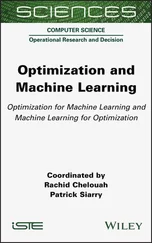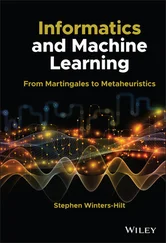Tormod Næs - Multiblock Data Fusion in Statistics and Machine Learning
Здесь есть возможность читать онлайн «Tormod Næs - Multiblock Data Fusion in Statistics and Machine Learning» — ознакомительный отрывок электронной книги совершенно бесплатно, а после прочтения отрывка купить полную версию. В некоторых случаях можно слушать аудио, скачать через торрент в формате fb2 и присутствует краткое содержание. Жанр: unrecognised, на английском языке. Описание произведения, (предисловие) а так же отзывы посетителей доступны на портале библиотеки ЛибКат.
- Название:Multiblock Data Fusion in Statistics and Machine Learning
- Автор:
- Жанр:
- Год:неизвестен
- ISBN:нет данных
- Рейтинг книги:3 / 5. Голосов: 1
-
Избранное:Добавить в избранное
- Отзывы:
-
Ваша оценка:
- 60
- 1
- 2
- 3
- 4
- 5
Multiblock Data Fusion in Statistics and Machine Learning: краткое содержание, описание и аннотация
Предлагаем к чтению аннотацию, описание, краткое содержание или предисловие (зависит от того, что написал сам автор книги «Multiblock Data Fusion in Statistics and Machine Learning»). Если вы не нашли необходимую информацию о книге — напишите в комментариях, мы постараемся отыскать её.
Explore the advantages and shortcomings of various forms of multiblock analysis, and the relationships between them, with this expert guide Multiblock Data Fusion in Statistics and Machine Learning: Applications in the Natural and Life Sciences
Multiblock Data Fusion in Statistics and Machine Learning: Applications in the Natural and Life Sciences
Multiblock Data Fusion in Statistics and Machine Learning — читать онлайн ознакомительный отрывок
Ниже представлен текст книги, разбитый по страницам. Система сохранения места последней прочитанной страницы, позволяет с удобством читать онлайн бесплатно книгу «Multiblock Data Fusion in Statistics and Machine Learning», без необходимости каждый раз заново искать на чём Вы остановились. Поставьте закладку, и сможете в любой момент перейти на страницу, на которой закончили чтение.
Интервал:
Закладка:
10 Part III Methods for Complex Multiblock Structures 8 Complex Block Structures; with Focus on L-Shape Relations8.i General Introduction8.ii Relations to the General Framework8.1 Analysis of L-shape Data: General Perspectives8.2 Sequential Procedures for L-shape Data Based on PLS/PCR and ANOVA8.2.1 Interpretation of X1, Quantitative X2-data, Horizontal Axis First8.2.2 Interpretation of X1, Categorical X2-data, Horizontal Axis First8.2.3 Analysis of Segments/Clusters of X1 Data8.3 The L-PLS Method for Joint Estimation of Blocks in L-shape Data8.3.1 The Original L-PLS Method, Endo-L-PLS8.3.2 Exo- Versus Endo-L-PLS8.4 Modifications of the Original L-PLS Idea8.4.1 Weighting Information from X3 and X1 in L-PLS Using a Parameter α8.4.2 Three-blocks Bifocal PLS8.5 Alternative L-shape Data Analysis Methods8.5.1 Principal Component Analysis with External Information8.5.2 A Simple PCA Based Procedure for Using Unlabelled Data in Calibration8.5.3 Multivariate Curve Resolution for Incomplete Data8.5.4 An Alternative Approach in Consumer Science Based on Correlations Between X3 and X18.6 Domino PLS and More Complex Data Structures8.7 Conclusions and Recommendations8.8 Open Issues
11 Part IV Alternative Methods for Unsupervised and Supervised Topologies 9 Alternative Unsupervised Methods9.i General Introduction9.ii Relationship to the General Framework9.1 Shared Variable Mode9.2 Shared Sample Mode9.2.1 Only Common Variation9.2.1.1 DIABLO9.2.1.2 Generalised Coupled Tensor Factorisation9.2.1.3 Representation Matrices9.2.1.4 Extended PCA9.2.2 Common, Local, and Distinct Variation9.2.2.1 Generalised SVD9.2.2.2 Structural Learning and Integrative Decomposition9.2.2.3 Bayesian Inter-battery Factor Analysis9.2.2.4 Group Factor Analysis9.2.2.5 OnPLS9.2.2.6 Generalised Association Study9.2.2.7 Multi-Omics Factor Analysis9.3 Two Shared Modes and Only Common Variation9.3.1 Generalised Procrustes Analysis9.3.2 Three-way Methods9.4 Conclusions and Recommendations9.4.1 Open Issues 10 Alternative Supervised Methods10.i General Introduction10.ii Relations to the General Framework10.1 Model and Focus10.2 Extension of PCovR10.2.1 Sparse Multiblock Principal Covariates Regression, Sparse PCovR10.2.2 Multiway Multiblock Covariates Regression10.3 Multiblock Redundancy Analysis10.3.1 Standard Multiblock Redundancy Analysis10.3.2 Sparse Multiblock Redundancy Analysis10.4 Miscellaneous Multiblock Regression Methods10.4.1 Multiblock Variance Partitioning10.4.2 Network Induced Supervised Learning10.4.3 Common Dimensions for Multiblock Regression10.5 Modifications and Extensions of the SO-PLS Method10.5.1 Extensions of SO-PLS to Three-Way Data10.5.2 Variable Selection for SO-PLS10.5.3 More Complicated Error Structure for SO-PLS10.5.4 SO-PLS Used for Path Modelling10.6 Methods for Data Sets Split Along the Sample Mode, Multigroup Methods10.6.1 Multigroup PLS Regression10.6.2 Clustering of Observations in Multiblock Regression10.6.3 Domain-Invariant PLS, DI-PLS10.7 Conclusions and Recommendations10.8 Open Issues
12 Part V Software 11 Algorithms and Software11.1 Multiblock Software11.2 R package multiblock11.3 Installing and Starting the Package11.4 Data Handling11.4.1 Read From File11.4.2 Data Pre-processing11.4.3 Re-coding Categorical Data11.4.4 Data Structures for Multiblock Analysis11.4.4.1 Create List of Blocks11.4.4.2 Create data.frame of Blocks11.5 Basic Methods11.5.1 Prepare Data11.5.2 Modelling11.5.3 Common Output Elements Across Methods11.5.4 Scores and Loadings11.6 Unsupervised Methods11.6.1 Formatting Data for Unsupervised Data Analysis11.6.2 Method Interfaces11.6.3 Shared Sample Mode Analyses11.6.4 Shared Variable Mode11.6.5 Common Output Elements Across Methods11.6.6 Scores and Loadings11.6.7 Plot From Imported Package11.7 ANOVA Simultaneous Component Analysis11.7.1 Formula Interface11.7.2 Simulated Data11.7.3 ASCA Modelling11.7.4 ASCA Scores11.7.5 ASCA Loadings11.8 Supervised Methods11.8.1 Formatting Data for Supervised Analyses11.8.2 Multiblock Partial Least Squares11.8.2.1 MB-PLS Modelling11.8.2.2 MB-PLS Summaries and Plotting11.8.3 Sparse Multiblock Partial Least Squares11.8.3.1 Sparse MB-PLS Modelling11.8.3.2 Sparse MB-PLS Plotting11.8.4 Sequential and Orthogonalised Partial Least Squares11.8.4.1 SO-PLS Modelling11.8.4.2 Måge Plot11.8.4.3 SO-PLS Loadings11.8.4.4 SO-PLS Scores11.8.4.5 SO-PLS Prediction11.8.4.6 SO-PLS Validation11.8.4.7 Principal Components of Predictions11.8.4.8 CVANOVA11.8.5 Parallel and Orthogonalised Partial Least Squares11.8.5.1 PO-PLS Modelling11.8.5.2 PO-PLS Scores and Loadings11.8.6 Response Optimal Sequential Alternation11.8.6.1 ROSA Modelling11.8.6.2 ROSA Loadings11.8.6.3 ROSA Scores11.8.6.4 ROSA Prediction11.8.6.5 ROSA Validation11.8.6.6 ROSA Image Plots11.8.7 Multiblock Redundancy Analysis11.8.7.1 MB-RDA Modelling11.8.7.2 MB-RDA Loadings and Scores11.9 Complex Data Structures11.9.1 L-PLS11.9.1.1 Simulated L-shaped Data11.9.1.2 Exo-L-PLS11.9.1.3 Endo-L-PLS11.9.1.4 L-PLS Cross-validation11.9.2 SO-PLS-PM11.9.2.1 Single SO-PLS-PM Model11.9.2.2 Multiple Paths in an SO-PLS-PM Model11.10 Software Packages11.10.1 R Packages11.10.2 MATLAB Toolboxes11.10.3 Python11.10.4 Commercial Software
13 References
14 Index
15 End User License Agreement
List of Figures
1 Chapter 1Figure 1.7 L-shape data of...Figure 1.1 High-level...Figure 1.2 Idea of dimension...Figure 1.3 Design of the plant...Figure 1.4 Scores on the first...Figure 1.5 Idea of copy number...Figure 1.6 Plot of the Raman...Figure 1.8 Phylogeny of some...Figure 1.9 The idea of common...
2 Chapter 2Figure 2.1 Idea of dimension reduction...Figure 2.2 Geometry of PCA...Figure 2.3 Score (a) and loading...Figure 2.4 PLS validated explained...Figure 2.5 Score and loading plots...Figure 2.6 Raw and normalised...Figure 2.7 Numerical representations...Figure 2.8 Classical (a) and...Figure 2.9 Classical (a) and...Figure 2.10 SCA for two data...Figure 2.11 The block scores...Figure 2.12 Two column-spaces...Figure 2.13 Common and distinct...Figure 2.14 Common components...Figure 2.15 Visualisation of a response...Figure 2.16 Fitted values versus...Figure 2.17 Simple linear regression...Figure 2.18 Two-variable multiple...Figure 2.19 Two component PCA...Figure 2.20 Illustration of true...Figure 2.21 Visualisation of bias...Figure 2.22 Learning curves showing...Figure 2.23 Visualisation of the...Figure 2.24 Cumulative explained...Figure 2.25 Null distribution...
Читать дальшеИнтервал:
Закладка:
Похожие книги на «Multiblock Data Fusion in Statistics and Machine Learning»
Представляем Вашему вниманию похожие книги на «Multiblock Data Fusion in Statistics and Machine Learning» списком для выбора. Мы отобрали схожую по названию и смыслу литературу в надежде предоставить читателям больше вариантов отыскать новые, интересные, ещё непрочитанные произведения.
Обсуждение, отзывы о книге «Multiblock Data Fusion in Statistics and Machine Learning» и просто собственные мнения читателей. Оставьте ваши комментарии, напишите, что Вы думаете о произведении, его смысле или главных героях. Укажите что конкретно понравилось, а что нет, и почему Вы так считаете.












